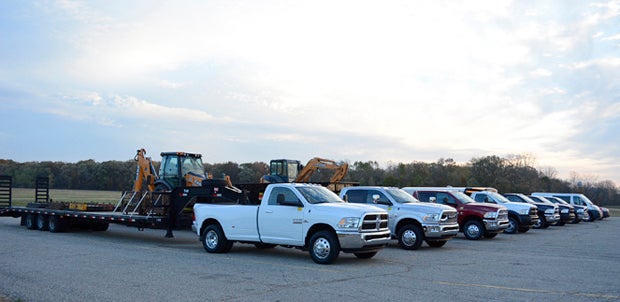
There’s towing, and there is towing.
While we at Off-Road.com make every effort to hitch something behind every pickup truck and other applicable vehicle we test in order to gain perspective on its performance when loaded, we admittedly don’t always have the equipment to seriously challenge the outer limits of most of the half-ton and three-quarter-ton 4x4s in the marketplace today. So, when Fiat Chrysler America (FCA) recently invited us to more or less play hookie from our daily grind and visit its Chelsea Proving Grounds near Ann Arbor, Michigan, for a day of extreme duty towing with its entire lineup of 2015 Ram trucks, we took them up on it faster than you can say algebra…or whatever class you sucked at in school.
A Little History
FCA is not unlike the other Big Three American auto manufacturers in the they all have a rich history and their truck models have come a long way in a short time, but perhaps nowhere is this more true than with the Ram truck line, which broke away from Dodge to become its own stand-alone brand in 2009. Since then, Ram has experienced 65 consecutive months of year-over-year sales growth, and the brand just enjoyed its best September since 2005. According to FCA, Ram has more than doubled its market share since 2009. Back then, Ram’s worldwide sales figures topped 169,000 units, but that figure is dwarfed by Ram’s projection of 400,000 units worldwide for 2015. According to Bob Hegbloom, Head of the Ram Brand, FCA – North America, the Ram success story starts with its products.
“In 2009, when we became a stand-alone brand, we started working on this portfolio of products, and we haven’t stopped,” Hegbloom said. “The one thing that we’ve been consistent with is that we have said, ‘We are not going to slow down. We are going to continue to deliver what people are asking for.’ That is what our current line-up represents.”
But you’d have to go back 20 years farther, all the way to 1989, to reach the true turning point that set the course for Ram’s future. That was the first year that Dodge partnered with Cummins to debut a Ram pickup with the inline six-cylinder Cummins turbodiesel. Sure, rival Ford already had a strong International-built diesel in its F-250s and F-350s, but it was a naturally aspirated rattler that delivered all of its torque in a very narrow range at a very low rpm before simply running out of breath. The Cummins’ turbo boost not only added capability, it added drive-ability, and it would go on to shift the paradigm in the heavy-duty truck world, fostering a turbodiesel-powered arms race that brings us back to where are today, with Cummins 6.7-liter Ram 2500 and 3500 trucks that feature a best-in-class 900 lb.-ft. of torque but also best-in-class towing and payload capabilities, even if those numbers are just barely ahead of Ford’s at the moment.
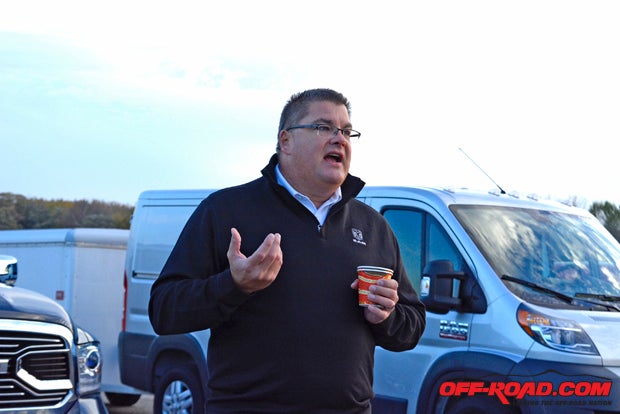
Not only that, Ram’s pro-turbodiesel philosophy has, of late, filtered down to its half-ton 1500, which can be had with an optional 3.0-liter EcoDiesel. It may not wear a Cummins badge, but the VM Motori-designed and manufactured V6 still delivers a stump-pulling 402 lb.-ft. of torque, while delivering EPA-certified 19 mpg city/27 mpg highway fuel economy—and it actually gets as much 29 mpg on the highway in two-wheel-drive trim. To say that Ram is excited about the newest diesel pickup platform in its lineup is an understatement, and Hegbloom put the EcoDiesel’s capability into perspective for us.
“It has 240 horsepower, 420 pound-feet of torque, and it tows over 10,000 pounds,” Hegbloom said. “In 1989 we came out with the 5.9-liter Cummins diesel that was 200 horsepower and 400 pound-feet of torque, and it was less than 10,000 pounds that that truck could tow. So the EcoDiesel has half the displacement, and yet it does all that the 5.9-liter did, and then some, while getting 29 miles per gallon. When you start thinking about those numbers, it is crazy to realize how far we have come.”
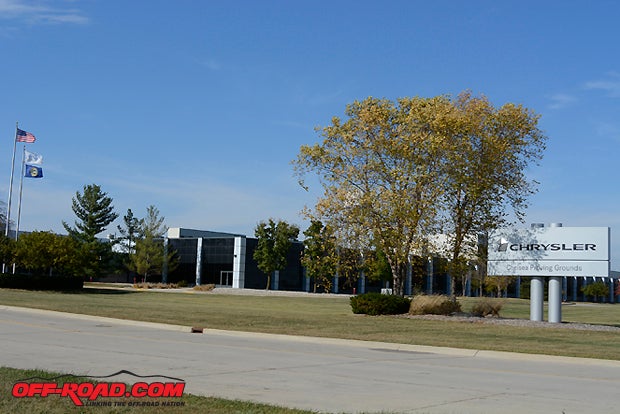
Our test loop at the Chelsea Proving Grounds was just that, a 4.3-mile loop that is known as the “Ride Evaluation Route.” It consists of two lanes. The outer lane can be used to evaluate vehicles at typical highway speeds while the inner lane features a host of pavement undulations, everything from large—and we mean large—potholes, divided concrete, washboard sections and numerous other surfaces that can be used when evaluating suspension capability. Unfortunately, there were no uphill stretches on the loop, which prevented me from testing the ability of these trucks to chug up a grade while loaded. FCA claims that Chelsea does have some hill routes with 7 percent, 15 percent and 32 percent grades somewhere on its 3800-acre property, but the plan was to stick with the prescribed loop. Too bad.
The Ratings Game
Ever wonder how a vehicle manufacturer comes up with a given payload or tow rating with which to use as a selling point? Can they make up or fudge numbers. The answer is no, but the testing standards for rating trucks used to be a lot more nebulous before the OEMs adopted the SAE J2807 standard, a standard by which vehicles that tow trailers are tested and rated.
SAE J2807 is not a government regulation, but rather it is the product of a committee of vehicle manufacturers working together to develop testing standards that allow an apples-to-apples comparison of their vehicles’ towing capabilities. It consists of four main parts: 1) vehicle setup; 2) powertrain and thermal testing; 3) chassis testing; and 4) trailer hitch hardware testing. The components of these main parts include an acceleration test, a passing maneuver test, a climbing test in extreme temperatures, dynamic testing to find handling limits, brake testing test and hitch testing.
Under the J2807 standard, the vehicle setup defines the weight of the vehicle that is going to tow. That calculation must include the curb weight of the vehicle, a combined passenger/driver weight of 300 lbs., optional truck accessories totaling 100 lbs., and any optional or non-standard trailering equipment. Unique hitches, such as fifth wheel or tag hitches, must also be included into the weight calculation. Conventional hitches require the OEMS to account for a minimum of 10 percent tongue weight when making the towing capacity calculation, while fifth-wheel and gooseneck hitches require a 15 percent tongue weight factor. Tongue weight is defined as the amount of mass lowered onto the vehicle.
To calculate the towing capacity, the standard takes the Gross Combined Weight Rating of the vehicle (GCWR), subtracts the trailer vehicle weight and factors in the tongue weight. For example, the Big Tex trailer and Case IH backhoe loaded behind the silver Ram 3500 Limited in this story was 29,395 lbs. The Ram 3500 offers a best-in-class GCWR of 39,100 lbs., and a best-in-class trailer weight rating of 31,210 lbs.
Powertrain and thermal testing consists of acceleration runs from 0-30 mph, 0-60 mph, passing maneuver while accelerating from 40 mph to 60 mph and a brutal climbing test known as Davis Dam. The Davis Dam test takes place on a 12-mile stretch of highway outside of Laughlin, Nevada, where temperatures start at 100 degrees Fahrenheit and the altitude starts at 500 feet above sea level and ending at 3500 feet above sea level with grades as steep as 7 percent scattered along the route.
The chassis testing is done to determine braking and handling safety while handling large loads. The brake test demonstrates a vehicle’s ability to maintain its lane during emergency vehicle braking while towing a load, and the dynamic test demonstrates a vehicle’s stability during lane-change maneuvers.
Trailer hitch hardware testing is required to ensure that the hitch can tow up to and including the maximum calculated towing capacity of the vehicle.
Ram’ is proud to note that it 1500, 2500 and 3500 trucks all comply with the SAE J2807 standard.
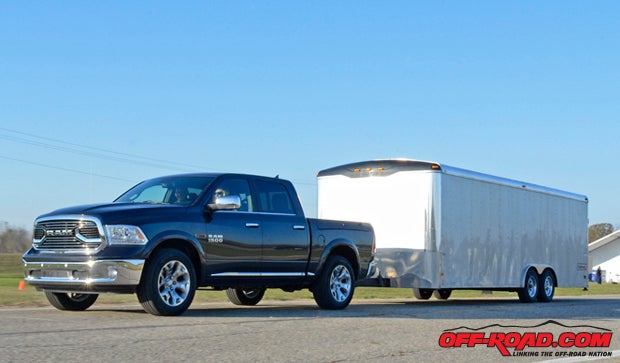
Ram 1500 EcoDiesel Limited Crew Cab 4x4
The Ram 1500 EcoDiesel Limited Crew Cab 4x4 was the first test vehicle on my schedule, though it was really more of a second round for me, as I had briefly sampled ORC’s Ram 1500 EcoDiesel test unit back in 2014. I’ll be honest in saying that back then I was none too impressed with the EcoDiesel’s getup-and-go. As someone who has ample experience with several generations of Cummins-powered Rams, the VM Motori V6’s lack of grunt out of the hole bothered me. I had hoped for a much more instantaneous response when I stepped on the accelerator, but the tiny V6 simply needed a few hundred rpm to spool up the turbo. I felt like I really had to mash the gas…er, diesel?
However, as it turns out, our original ORC test unit was equipped with a 3.55:1 rear axle ratio, while the test unit that was hitched to a 5800-lb. enclosed car trailer at Chelsea sported the optional 3.92:1 rear axle ratio. Hmm, 3.55:1… 3.92:1… How much of a difference can that slightly steeper rear end ratio make? In my opinion, all the difference in the world. Put another way, the truck at Chelsea almost felt like it accelerated harder down low even with the trailer behind it than did the truck we tested in Southern California without the trailer!
If that sounds like an embellishment, it should be noted that there are a couple factors at work here. The first is that the steeper 3.92 gearing creates more rpm at a given wheel speed than the 3:55s, and in the case of the EcoDiesel it is just enough to get help the motor pull through its low-end tender spot and get on boost quicker, which makes the engine feel more robust. The second has to do with the nature of turbos themselves, which actually perform better under a load because that load increases the expansion of combustion gases in the cylinders, which also means an increase in exhaust gas pressure and temperature. Since exhaust gases are what drive the turbocharger, a turbo under a heavy load will spin faster at a given rpm than an unloaded one, thus making more power.
Regardless of the theory, the fact is that the Ram 1500 EcoDiesel had no issues handling a load that is pretty much in line with those your typical half-ton truck owner might pull on a semi-frequent basis. Despite not weighing as much as the 2500 or 3500 trucks, the 1500 had no trouble maintaining a smooth ride and holding its lane with the trailer behind it. I also appreciated how smoothly the 1500’s eight-speed TorqueFlite transmission shifted smoothly from gear to gear without any lag or hitch. The only other thing I noticed was that the VM Motori engine lacks an exhaust brake, not that it’s any big deal, as a properly equipped trailer loaded to 9200 lbs. should be equipped with brakes of its own anyway. I attempted a panic braking maneuver from 70 mph while out on the loop, and the package came to stop safely and smoothly. Overall, I would give the truck a very good rating for towing capability.
Price? Well, for that the Limited package, that’s another matter entirely, as our fully optioned Limited test model came to a wallet-busting $60,395, planting it perilously close in price point to many of Ram’s 2500 nicely-optioned trim packages. If a diesel with great fuel economy is what you are after, however, the 1500 EcoDiesel reigns supreme in the Ram lineup.
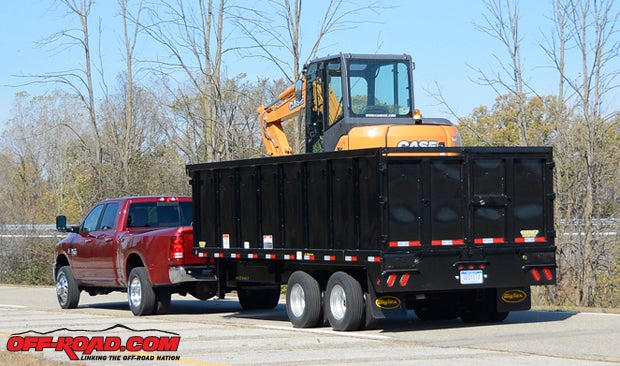
Ram 3500 Big Horn Crew Cab 4x4 Long Box/3500 SLT Long Box
I initially side-stepped the Ram 2500 Limited 4x4 Crew Cab on hand, as it featured a 12,300-lb. trailer configuration similar to that which we have already experienced plenty of towing with this class of Ram (SEE: 2014 Laramie, 2015 Tradesman). Nope, I wanted to jump right into the 3500 dualies. These bad boys are the tow kings of Ram’s heavy-duty truck line, and FCA made sure to provide us with test units with the right features for towing extraordinarily heavy loads.
I selected a sweet-looking red Ram 3500 Big Horn Crew Cab 4x4 mated to a Big Tex trailer filled with a Case CX55B excavator. The trailer and the excavator added up to a 20,820 lbs. of tow load, more than I had ever put behind any truck. Pulling out of the staging area, I hammered the throttle and wasn’t at all surprised at just how easily the Big Horn got the load up to 55 mph. Its Cummins 6.7-liter inline six boasts 385 horsepower and a best-in-class 900 lb.-ft. of torque at just 1700 rpm, allowing Ram to engineer a truck that delivers a best-in-class tow rating of 31,210 lbs. and a best-in-class payload of 7390 lbs.
Contributing to the Ram’s power production is an industry-exclusive Ram Active Air intake system. When the intake system senses extreme heat, it draws cooler air from the front of the vehicle to help make power while reducing engine temperatures. The system also engages at high altitudes to give the Cummins better throttle response when the air is less dense. In wet or snowy conditions, or when fording ice or water, the system pulls air from an under-hood inlet to keep moisture out of the intake.
The engine is mated to an Aisin six-speed automatic transmission (AS69RC) designed with wide gear ratios designed to maintain efficiency and drivability while retaining good towing performance, and it transmits torque to a beefy 11.8-inch rear end with a steep 4.10:1 rear axle ratio. However, the 3500 does not feature the innovative five-link coilspring rear suspension design used with the 2500. It continues to utilize Hotchkiss-style leaf springs, but Ram does offer an optional air suspension system on both single rear-wheel and dualie Ram 3500 models. By adding the supplemental air bags to the rear suspension, Ram Truck engineers were able to soften the leaf springs to give the 3500 a more comfortable unladen suspension feel.
When the truck is loaded to a high-load capacity, however, the air suspension system automatically fills the rear air bags to level the truck for improved stability and ride quality. I certainly had no complaints about the ride quality of the Big Horn as I negotiated our test loop. The truck accelerated briskly, handled well with the load, and braking was smooth and even. Although the weight of the Case excavator and Big Tex trailer made its presence known during cornering and braking maneuvers, the Ram chassis and suspension kept everything in line, and the mighty Cummins never broke a sweat.
But, as usual, if you want this much truck, be prepared to pay for it. As tested the Big Horn 3500 retails for $65,700, almost 21 grand more than the base Hemi model, although the Cummins 6.7-liter accounts for $8995 of that increase. Escalating truck prices are something that we at ORC have expressed concern about in the past, and I mentioned this to one FCA official during one of our test sessions. He understood, but he also made the point that while Ram does offer Cummins-powered models at lower price points, “We see that the majority of our customers for these trucks are people involved in construction or some other industrial occupation. Then there is also the guy with the $30,000 horse trailer filled with maybe $100,000 worth of horses, they don’t see price levels for trim packages such as our Limited to be out of line.” Point taken.
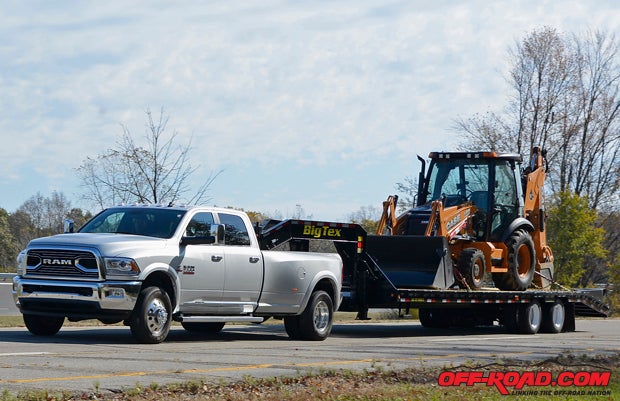
Although we rarely get behind the wheel of non-4x4 machines, I needed to know how a Ram 3500 drives when saddled with near its maximum towing capacity, and Ram provided us that opportunity at the Ram Heavy Hauler event by outfitting a Ram 3500 SLT Regular Cab model with a 40-foot trailer loaded with steel for a total towing weight of 31,135 lbs., a mere 75 lbs. shy of the Ram’s max towing capability. It is important to note that Ram selected the 4x2 and the single cab for one important reason: 4x4 powertains and crew cabs add weight to the vehicle, which takes away from the towing and payload capacity, and that’s something to consider if you are trying to squeeze every last pound of either capacity out of your daily driver.
Heading out onto the test loop, I stepped on the throttle the same way that I had with the Big Horn, and lo and behold, the Cummins 6.7-liter turbodiesel actually strained a little bit to get the load up to speed! By a little bit, I mean a very little bit, but there was simply no denying that this was an insanely heavy load, one that was only able to be capably towed by Class 6 or 7 commercial trucks just a couple years ago. It was making the Cummins work even with the 4.10:1 rear gear, and getting the load up to 55 mph took a little longer than it did with Big Horn. Even so, the Cummins had enough torque to get it moving steadily.
And when it came time to decelerate, I was glad to have the Cummins Smart Exhaust Brake system working for me. Activated in Tow/Haul mode, the Smart Exhaust Brake system activates to build exhaust back pressure, effectively using the trucks own compression to help slow it down when descending steep grades. What makes it so “smart” is its adjustability—it can be dialed-in to hold a preset speed when descending, and the system will automatically engage to hold that speed regardless of whether you initiate braking or simply take your foot off the throttle.
Even with the largest load, the Ram handled admirably, guiding the trailer down the road rather than the other way around, and it handled as well as we expected it to while continuing to maintain a comfortable ride.
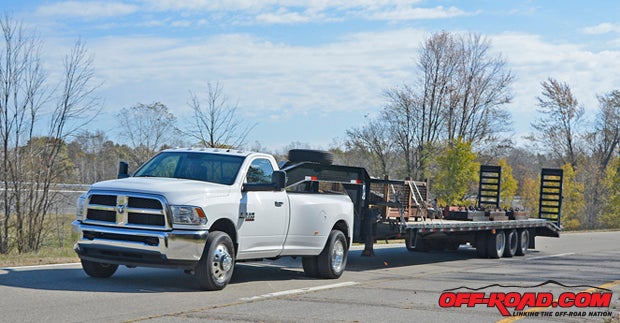
Bottom Line
Where it pertains to the Cummins-powered Rams, we experienced loading capacities with which few truck owners will ever saddle their rigs unless they are involved in some sort of construction of other heavy commercial occupation. Our tow day at Chelsea merely reinforced that Ram walks its talk. It is clearly committed to building the best heavy-duty pickups on the planet, and Cummins turbodiesel power is the cornerstone feature in its 3/4-ton and 1-ton offerings. However, Ram also tries to meet customer needs with more than just brute force, incorporating innovative suspension designs with air bag-assisted load-leveling capability and such intelligent features as a Smart Exhaust Brake system, optional cab-mounted back-up camera that makes it easy for one person to hook onto a fifth-wheel trailer, integrated bed lights and an integrated fifth-wheel trailer package in its Heavy Duty 2500 and 3500 models.
What’s even more interesting than all of this is that Ram has just begun to scratch the surface of the potential for the 1500 EcoDiesel and the 2500/3500 Cummins powertrains. As one official put it to me, Ram can still develop these powertrains for even more performance and work capability as needed. Ram is at the top of the mountain in terms of towing and payload capability today, and it intends to say there tomorrow.


 Your Privacy Choices
Your Privacy Choices